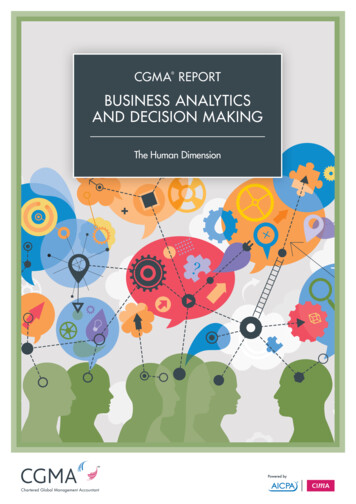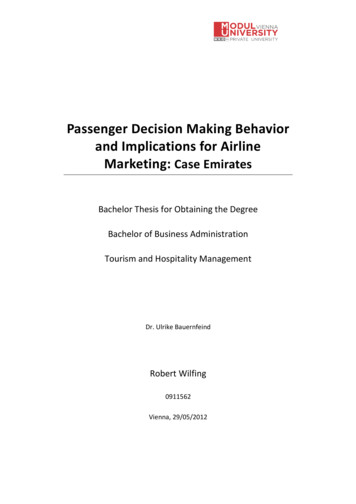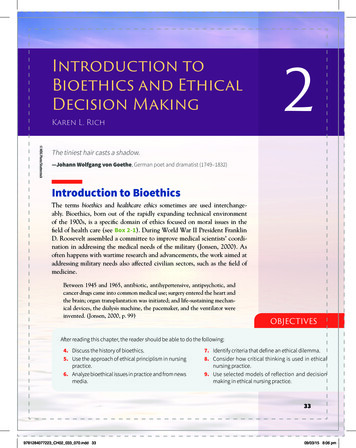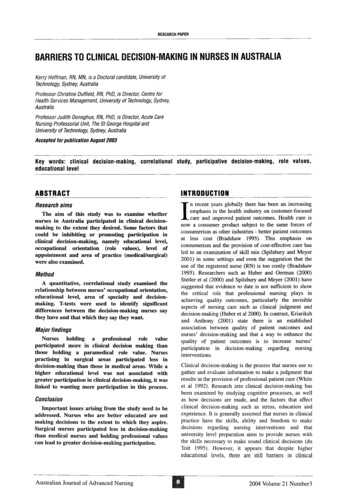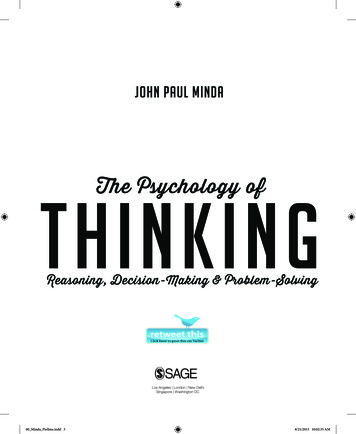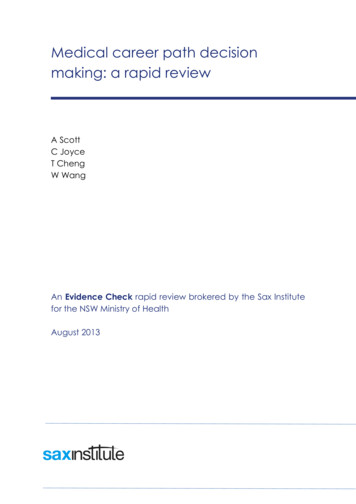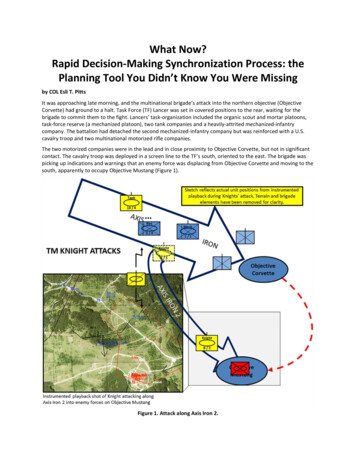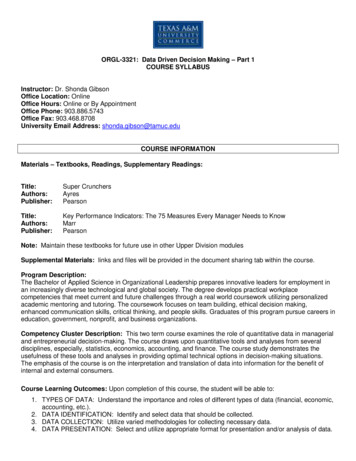
Transcription
Copyright 2001 by the American Psychological Association, Inc.0022-3514/01/S5.00 DOI: 10.1037//0022-3514.80.6.918Journal of Personality and Social Psychology2001, Vol. 80, No. 6, 918-930Quality of Decision Making and Group NormsTom Postmes and Russell SpearsSezgin CihangirUniversity of AmsterdamFree University AmsterdamTwo studies investigated the impact of group norms for maintaining consensus versus norms for criticalthought on group decisions in a modification of the biased sampling paradigm (G. Stasser & W. Titus,1985). Both studies showed that critical norms improved the quality of decisions, whereas consensusnorms did not. This effect appeared to be mediated by the perceived value of shared and unsharedinformation: Consensus norm groups valued shared information more highly than critical groups did, andvalence was a good predictor of decision outcome. In addition, the 2nd study showed that the group normmanipulation has no impact on individual decisions, consistent with the assumption that this is a groupeffect. Results suggest that the content of group norms is an important factor influencing the quality ofgroup decision-making processes and that the content of group norms may be related to the group'sproneness for groupthink."biased sampling paradigm," groups can arrive at a correct decision by pooling information that is given to members individually.However, groups surprisingly fail to be more effective than individuals: Members do not pool critical information, and the qualityof decisions is low (Wittenbaum & Stasser, 1996, for a review).Stasser and Titus (1985) conducted the first investigation in thisparadigm with a "hidden profile" of job candidates. Such a hiddenprofile does not distribute all characteristics equally among groupmembers. Some information is shared among all group members,and some is "unshared": given to individual group members only.If, for example, all the positive information about one candidate isunshared, this candidate appears to be less good on average than ifall information were pooled. In this fashion, so-called hiddenprofiles may exist that are designed to lead to a correct solutiononly if unshared information is discussed within the group. Thedegree to which groups reach the correct solution is thus a measureof the quality of group decision making. Stasser and Titus's (1985)study compared the performance of groups that shared all information with groups having unshared information. When all thenecessary information about the candidates was shared amongparticipants, they reached correct decisions 68% of the time without discussing this information in the group, and group discussionslightly improved performance, to 83% correct decisions. In contrast, when not all information was shared among participants,individual decisions were of poorer quality, as is to be expected:Only 25% of decisions were correct. Group discussion did notimprove decision quality, however, and even deteriorated thedecision quality somewhat, to 20% correct in one condition and to17% in another. These results suggest that unshared information isnot routinely pooled in discussion, which causes group decisions tobe no better than individual decisions in this particular task.A large body of literature has investigated dysfunctional properties of group decisions and groups in general. For example,groups have been described as inefficient, unimaginative, inaccurate and unproductive (e.g., Stroebe & Diehl, 1994; see Baron,Kerr, & Miller, 1992, for a review). One very influential study ofgroup decision making has argued that groups may be prone togroupthink, a drive for consensus that overrides realistic appraisalof decision alternatives (Janis, 1982; see Esser, 1998, and Paulus,1998 for reviews). The source of groupthink is a group's cohesion,which goes hand in hand with a lack of criticism. In the presentresearch, we investigated the possibility that cohesion is not necessarily the cause of the problem (and may even be a part of thesolution) with regard to faulty decision processes. We examine theidea that group norms may influence the quality of group decisionsindependent of factors relating to group cohesion. Specifically, wefocus on the role of group history in the formation of critical versusconsensual group norms that may boost or deteriorate the qualityof group decisions.Biased SamplingIn an examination of the pooling of information in decisionmaking groups, Garold Stasser and his associates developed anexperimental paradigm in which groups would seem almost certainto outperform individuals (e.g., Stasser & Titus, 1985). In thisTom Postmes, Department of Communication, University of Amsterdam, Amsterdam, the Netherlands; Russell Spears, Department of SocialPsychology, University of Amsterdam, Amsterdam, the Netherlands; Sezgin Cihangir, Department of Social Psychology, Free University Amsterdam, Amsterdam, the Netherlands.We are very grateful to Wouter ter Haar, Khaled Sakhel, Astrid Homan,and Kathrin Tsainis for their help in conducting the research.Correspondence concerning this article should be addressed to TomPostmes, who is now at the Department of Psychology, University ofExeter, Exeter EX4 4QG, England. Electronic mail may be sent tot.postmes@exeter.ac.uk.The authors suggested the biased sampling model to account forthese findings. According to this model, group decisions are basedon evaluation of information that is available. Evaluating eachcharacteristic of a candidate in a similar way to that proposed bypersuasive arguments theory (e.g., Burnstein & Vinokur, 1977),people aggregate the pros and cons to come up with a judgment of918
GROUP NORMS AND GROUP DECISIONSwhich candidate is superior. This implies that if information wereto be shared among all group members, people would be able tomake the correct decision: Decisions are based on the informationat hand. To account for the finding that no pooling occurs, thebiased sampling model offers two explanations that could operatein conjunction, one probabilistic and one motivational. First, thereis a greater a priori probability that shared information will bementioned during discussions. Statistically the chance of an itembeing mentioned is greater for a shared item than for an unshareditem, because the shared item is known to more people. Accordingto the second (motivational) explanation, information entered inthe discussion favors the initial preference more than the alternatives. People are more motivated to enter arguments in discussionsthat support their own views. This would lead to an exchange ofarguments supporting the wrong candidate in the hidden profilesituation. Both these explanations would account for the failure ofgroups to focus on shared information and not pool unsharedinformation.Many studies have since confirmed that groups do not paysufficient attention to the unshared information and consequentlymake inadequate decisions (e.g., Hollingshead, 1996; Larson,Christensen, Abbott, & Franz, 1996; Larson, Christensen, Franz, &Abbott, 1998; Larson, Foster-Fishman, & Franz, 1998; Larson,Foster-Fishman, & Keys, 1994; McLeod, Baron, Marti, & Yoon,1997; Schittekatte & Van Hiel, 1996; Stasser & Stewart, 1992;Stasser, Taylor, & Hanna, 1989; Stasser & Titus, 1985, 1987;Stasser, Vaughan, & Stewart, 2000; Stewart, Billings, & Stasser,1998; Stewart & Stasser, 1995, 1998; Winquist & Larson, 1998;Wittenbaum, 1998). Moreover, this bias to favor shared information appears to be a very robust phenomenon (e.g., Wittenbaum,1998). For example, Stasser et al. (1989) showed that groups withinstructions designed to improve decision making did not performany better than groups without instructions. Likewise, Larson et al.(1994) attempted to improve the quality of group decisions byproviding decision training and by varying task importance. However, these factors also failed to improve decisions. One of the fewsuccesses so far in substantially improving decision quality wasbased on manipulations of the nature of group tasks. Stewart andStasser (1998; see also Stasser & Stewart, 1992) demonstrated thatdecision quality improved in a hidden-profile situation as a function of the task type. When groups were informed that theirs wasa task in which one correct answer existed (a "solving" task), morecorrect solutions were obtained compared with instructions thatevidence was incomplete, but a most likely alternative would haveto be selected (a "judge" task; cf. Laughlin, 1980). It was shownthat the solve groups outperformed the judge groups, and that solvegroups paid more attention to "critical cues" (i.e., those thatdistinguish between decision alternatives).In sum, the biased sampling studies suggest that when it comesto unshared information, groups fail to consider pieces of information that are crucial for making the best decisions (Wittenbaum& Stasser, 1996). Moreover, this is a persistent effect: Improvements appear to be minimal even if groups are made aware thatthey should pool information. In this respect, the biased samplingparadigm has some similarities to Janis's (1982) groupthink cases,in which disconfirming evidence was ignored despite ample warnings of imminent disaster. The implication of this groupthinkanalogy is that an improvement of decision making within thebiased sampling paradigm could be obtained if groups would919invest energy in the critical examination of decision alternatives.The present research therefore examines possible reasons for thisdevotion of groups to initial decisions, and the inclination to ignoredisconfirming evidence. Specifically, we focus on the possibilitythat this devotion may be influenced by group norms to reachconsensus and may be reduced by making salient different kinds ofInfluences of Norms in Decision-Making GroupsGroup norms perform an important regulatory function in smallgroups (Baron et al., 1992; Levine & Moreland, 1990, for reviews), although the influence of norms on group decisions inparticular has not been investigated in many studies. A group normis defined as a standard or rule that is accepted by members of thegroup as applying to themselves and other group members, prescribing appropriate thought and behavior within the group. Groupnorms may be situationally and locally defined, and hence may bequite independent and distinct from social norms that exist at thelevels of communities and society (Postmes & Spears, 1998;Sherif, 1936). Such local group norms may have substantial impactin eliciting conformity to specific ideas or solutions (see alsoLevine & Moreland, 1991). Groups often have norms that promotethe importance of consensus per se (such as appears to be the casein Japanese organizations; e.g., Hofstede, 1980). However, insome other groups it may be the case that deviance and criticalthought are seen as desirable behavior for group members. Indeed,norms for individual independence of thought may exist in somegroups (many of the academic community's scholarly values speakto this point). Thus, independence of thought and cohesivenessmay not be so antagonistic as to preclude the possibility thatotherwise cohesive groups may have norms that encourage criticism and dissent.Norms and the Perceived Value of InformationWithin the biased sampling paradigm, these group norms ofconsensus versus independence may have an important impact onhow group members value shared information versus unsharedinformation. Within groups in general, consensus performs important functions. For example, subjective validity is achieved whenthere is a perceived consensus about information (Asch, 1952;Turner, 1991). This implies that the perceived validity of information in a group context may in part be socially established, at leastif consensus is an important factor for group members. Therefore,it may be the case that within certain groups shared and unsharedinformation differ beyond the mere availability of items: Sharedinformation can be validated socially (all members being aware ofthis information), whereas unshared information cannot (e.g., Larson et al., 1994; Stasser, 1992). This implies that if achievingconsensus is important for a group, shared information should bevalued more highly than unshared information, although the informational value of different items might appear to be equal to anoutsider or to a person less invested in group consensus.We argue that this differential evaluation of shared and unsharedinformation depends on characteristics of the group, however.Within a group that promotes independence and critical thought,information ought to be validated and assessed critically andindependently, and information should be validated according to
920POSTMES, SPEARS, AND CIHANGIR"objective" standards and individual thought. In this case groupmembers could treat every piece of information as equally valid,with little distinction between shared and unshared information.However, if the group's norms are strongly tilted toward reachingconsensus, we argue that shared information will be regarded ashaving higher value, because it reflects and feeds this consensus.The characteristics of the biased sampling paradigm are such thatvaluing shared information will lead to a higher probability ofincorrect decisions. Dwelling on shared information reinforces theinitial (faulty) decision and precludes the investigation of alternatives that may be better. Indeed, the very consensus of the information may be seen as contributing to the perceived correctness ofthe decision, so that even if all information were eventually to beshared during the discussion, information common to all may stillbe valued more highly than unshared information. Thus, groupswith a norm prescribing consensus should, on average, be lesslikely to reach correct decisions in the biased sampling paradigmthan are groups with a norm of critical and independent thought.However an independent empirical test had to be conducted to testthese predictions.In sum, the present research explored an additional cause (andpotential remedy) for faulty decision making in the biased sampling paradigm. This process relies not so much on the sampling ofshared and unshared information, as on the value attached to itemsof information that are common to all members of the group, anditems of information that are unique to individual group members.1We hypothesized that the evaluation of shared and unshared information is moderated by group norms. Specifically, we focusedon group norms of consensus and norms promoting dissent, whichwe refer to as consensus norms and critical norms, respectively.Groups with consensus norms should value shared informationmore highly compared with unshared information and comparedwith groups with critical norms. This differential evaluation, inturn, should affect the quality of group decisions: Groups with aconsensus norm are predicted to make poorer decisions than aregroups with critical norms.Overview of StudiesWe report two pilot studies and two experiments designed to testthe hypothesis that group decision making could be improved byinducing a critical group norm, whereas group decisions would notimprove when a consensus norm is activated. We examineddecision-making processes in situations in which information isnot equally available to all members of a small group, addressingtheoretical issues of group decision making in a biased samplingparadigm. In addition, we tested the assumption underlying thegroupthink hypothesis (Janis, 1982), but extended the theoreticalbasis for this idea by taking into account the role of group normsin inducing an atmosphere of uncritical assent that seems to havecontributed to the disastrous decisions characterizing this phenomenon. The method used to make group norms salient is developedin the pilot studies.Pilot StudiesIn two pilot studies, we sought to establish that it is possible toinduce group norms of consensus and critical norms. This wasdone by providing a group with a specific task that steers people'sinferences and attributions about the group and its social norms.The challenge is in showing that these norms can be promoted,while showing that they do not lead to differences in groupcohesiveness.Several studies have confirmed the idea that experience generated during group history may help establish a group norm (Jacobs& Campbell, 1961; Sherif, 1936). Group members induce groupnorms from observing the behavior of other group members, andpossibly of themselves as well (Postmes, Spears, Sakhel, & DeGroot, in press). Thus, in the pilot we examined the impact ofsmall tasks on group members' perceptions of the group and ofgroup norms, anticipating that these perceptions would influencetheir performance on subsequent tasks. As mentioned, one aim wasto invoke a critical versus a consensus norm, whereas a second aimwas to keep cohesiveness constant. We reasoned that both taskswould therefore have to be tasks that kept the unity of the groupintact. A critical norm could be fostered when group memberscollaborate to perform a task in which independence and uniquecontributions are essential to achieve a group goal. Specifically,we instigated a group discussion on a policy proposal about whichit would be easy to reach complete agreement, namely that this wasa bad proposal. Thus, we gave groups the task to discuss a proposalthat they would likely rapidly agree is a bad one. We reasoned thatcritical and independent thought would be tolerated and valuedbecause this was essentially the purpose of the group, but that theultimate agreement about the proposal would be beyond doubt, andwould preserve the cohesiveness of the group.In contrast, in a group in which the primary task was one ofcollaboration to reach a common goal (rather than to debate), weanticipated that a norm of consensus would emerge. We thoughtthat engaging in a collective creative task such as making a posterwith the group would require harmonious and consensual collaboration. In this task, each group member contributed to the endproduct by performing one of several tasks (selecting images,cutting them out, putting images together, etc.). In such a grouptask, the individual contributions are of secondary importance tothe group product and differences between group members mightactually threaten the group goal. Therefore critical and independent thought should be less desirable and normative thanconsensus.Pilot 1Method. Thirty-four undergraduates participated in return for coursecredit. Participants were randomly divided into eight groups of 3 to 5members and seated around a table. The norm manipulation consisted of a10-min group assignment. In the consensus norm condition participantswere given a pile of glossy magazines, two scissors, glue, and a large sheetof paper. Groups were given the following instructions:In the first part of this study all groups will make a poster in 10minutes. With old magazines, glue and a scissors you can make any1Indeed, to test these predictions one needs to ensure that biasedsampling is no longer an issue during group discussions. Availability ofunshared information may interfere with the value attached to shared orunshared information, because each new piece of information affects therelative diagnosticity of other items. To reduce this disturbance, in thepresent studies we made modifications to the biased sampling paradigm toensure that all information would be shared prior to group discussion.
921GROUP NORMS AND GROUP DECISIONSposter according to your own taste. Make sure that every groupmember contributes to the final result.Participants were thus stimulated to make communal decisions about theposter. In the critical norm condition participants were given the followinginstructions:In the first part of this study all groups will judge a policy proposal.You are asked to discuss this proposal for 10 minutes, and decide whatyour group thinks of this proposal. Make sure you reach a commonopinion. If you cannot agree, take the average of opinions as the groupopinion.Participants then discussed the following proposal: "People who graduatedfrom University should pay extra taxes to finance student scholarships."Pretesting revealed that virtually all students were against this proposal.Group opinions were recorded on an answering sheet with a 7-point ratingscale ranging from 1 (disagree) to 7 (agree).After the group task participants individually filled out a questionnaire.Three questions were concerned with the perceived norms of group members: "People in this group generally are critical," "People in this groupgenerally adjust to each other" (recoded), and "This is a critical group."These questions were combined into one scale (a .79). To check for thecohesiveness of groups, we aggregated the levels of group identification foreach member into a group-cohesiveness score (cf. Hogg, 1992). The scaleconsisted of four questions: "I feel connected to the people in this group,""I like to see myself as a member of this group," "I identify with themembers of my group," and "I am like the others in this group" (a .11).These questions were answered on 7-point rating scales ranging from 1(disagree) to 7 (agree).Results and discussion. Results of the pilot (and of all otherstudies reported in this article) were analyzed at the group level.Groups easily reached consensus on the discussion task, as expected, and no problems were encountered with collating theposters. Results of t tests indicated that the group norm appearedto be manipulated successfully: Groups in the critical norm condition estimated their groups to be more critical (M 4.40, SD .45) than did groups in the consensus norm condition (M 3.05,SD .46), ?(6) 4.17, p .01. Moreover, the differences incohesiveness between critical groups (M 3.26, SD .59) andconsensus groups (M 3.36, SD .17) were not reliable,t(6) 0.35, p .74, ns. Thus we did not find any effect of thegroup norm on degree of cohesiveness. These results confirm thatthe norm manipulation was successful in affecting the perceivedgroup norm, but had no reliable impact on the cohesivenessmeasure.Although results suggest that the manipulation of the groupnorm was successful, the number of groups was small. Moreover,the group norm measure referred to perceived personal norms ofgroup members. Group norms also prescribe behavior of groupmembers and are perceived as properties of the group as a whole.We conducted a second pilot study to verify that the effects of thegroup norm manipulation were indeed normative in the sense thatthey had prescriptive properties and were perceived as groupproperties beyond group members' personal norms.Pilot 2Method. Thirty-six undergraduates participated in return for coursecredit. Participants were randomly divided into 12 groups of 3 members.The group tasks and the instructions to perform the tasks were identical tothe first pilot study, as was part of the questionnaire. The scales of theperceived group members' norms (a .88) and cohesion (a .82) wereincluded as in the previous pilot. However, two measures of the groupnorm were added to the questionnaire. The difference between the measures of group norm that we added to the scale and the one that waspreviously included was that, whereas the previous scale asked for perceptions of group members' personal norms, the added scales asked directlyhow participants perceived the norms and expectancies of the group as awhole.The first addition was a scale of critical group-norm perception. Thisscale consisted of three items: "In this group you should think critically,""In this group you ought to act independently," and "In this group you areexpected to make an independent contribution" (a .72). The secondaddition was another scale consisting of three statements to measure if theperceived group norm was consensual. The statements were "In this groupyou should contribute to the group's goals," "In this group you ought toalign yourself with the opinions of other members," and "In this group youshould conform to the others" (a .73). Items were answered on 7-pointrating scales ranging from 1 (disagree) to 7 (agree).Results and discussion. Results from t tests indicated that thegroup norm manipulation was successful. Groups in the criticalnorm condition perceived other group members to be more critical(M 5.19, SD 0.81) than did groups in the consensus normcondition (M 3.37, SD 0.63), r(10) 4.35, p .001. Inaddition, participants in the critical norm condition perceived thenorm of the group as a whole to prescribe that group membersshould be more critical (M 5.11, SD 0.85) than did participants in the consensus norm condition (M 3.76, SD 0.83),f(10) 2.78, p .019. Conversely, participants believed that theirgroups had a more consensual norm in the consensus norm condition (M 4.59, SD 0.54) than did participants in the criticalnorm condition (M 3.20, SD 0.73), ?(10) 3.75, p .004.As in the previous pilot study, no difference was found in cohesiveness between groups in the critical norm condition (M 4.25,SD 0.78) and consensus norm condition (M 3.70, SO 0.68),f(10) 1.32, p .22, ns. Thus, we did not find any indication thatcohesiveness within groups was affected by the normmanipulation.The results of these pilot studies indicate that group norms canbe successfully manipulated by giving groups a particular task towork on. Having a group discussion fosters the inference of acritical norm within the group (both with regard to group membersand to the group as a whole), and the task to collate a poster fostersthe formation of a consensual and less critical group norm. Whenthe effects of the norm manipulations on group cohesiveness werecompared, the difference between conditions was nonsignificantand descriptively small.Study 1Having established the effect of a prior task on the perceivedgroup norm, we now are in a position to test the main predictions.To reiterate briefly, the first study investigated the impact of groupnorms on the quality of decisions in the biased sampling paradigm.As in the pilot study, the formation of group norms was manipulated with prior tasks. In an ostensibly unrelated experiment following this task, participants made individual decisions based onincomplete profiles of job candidates (Phase 1 of the decisionmaking process), followed by a group discussion about the candidates in which they were asked to reach consensus (Phase 2). Wepredicted that groups with consensus norms would value sharedinformation more highly than unshared information, whereas
922POSTMES, SPEARS, AND CIHANGIRgroups with a critical norm would value unshared and sharedinformation more equally. To test this prediction, however, wemade a modification to the biased sampling paradigm to ensurethat all unshared information was equally available to group members at Phase 2, the group discussion.2 Without this modification,the unequal sharing of information would interfere with its evaluation, because the relative value of individual items is alteredeach time a new piece of information is learned. Therefore, weensured that all information was available at the start of thegroup-discussion phase. We predicted that the unequal evaluationof information leads to more correct decisions in the critical normgroups compared with the consensus norm groups.MethodParticipants. Participants were male (n 33) and female (« 39)undergraduate students who participated in exchange for course credit.They were randomly assigned to 18 groups of 4 participants who performed two ostensibly unrelated tasks. After the completion of a prior taskdesigned to instigate a norm toward group consensus, or a prior taskstimulating a critical group norm, participants were asked to make individual and then group decisions.Procedure and measures. Participants were informed that they wouldparticipate in two unrelated experiments. In what they thought was the firststudy, participants were instructed to complete an initial group task thatwas identical to the pilot. Thus, half the groups had a brief discussion aboutan unrelated policy proposal, and half the groups made a poster. Then,participants were informed that the second study required them to makeindividual and group decisions. Participants were separated and placed inan isolated cubicle containing a desk with a Macintosh computer, a sealedenvelope, and an instruction sheet with the profiles of three candidates fora university position and a response sheet attached. Participants wereinstructed to read the instruction sheet, which informed them of their taskto pick the candidate who in their view was most suited for a facultyposition at the university. On the response sheet, they were asked to circlethe best candidate. All this was done privately.After participants had completed the individual task, they receivedinstructions from the computer for the group discussion. These instructionsexplicitly informed them that the profiles had been incomplete, and thateach group member had been given some unique information. They wereasked to retrieve new profiles from the envelope on their desk, and wereinformed that the information previously hidden to them (i.e., unsharedinformation) was now printed in bold and that the information common toall group members (shared information) was on the bottom half of thesheets. They were then instructed to discuss the candidates with their groupand reach unanimous consensus about the best candidate. These discussions were conducted through a Macintosh computer in front of them, onwhich a synchronous computer conference was conducted (cf. McLeod etal. 1997, for a discussion of the utility of these computer-mediateddecisions). The system used was TownMeeting, a basic group-decisionsupport system for the Macintosh platform. During these discussions, agroup tag and individual identifying numbers identified each commentmade by group members.
Postmes, who is now at the Department of Psychology, University of Exeter, Exeter EX4 4QG, England. Electronic mail may be sent to t.postmes@exeter.ac.uk. "biased sampling paradigm," groups can arrive at a correct deci-sion by pooling information that is given to members individually. Howeve

